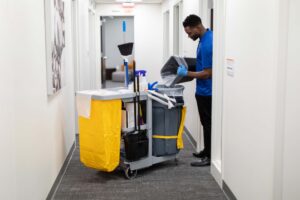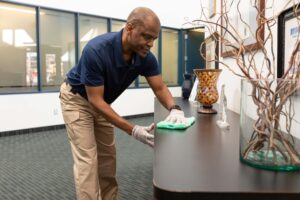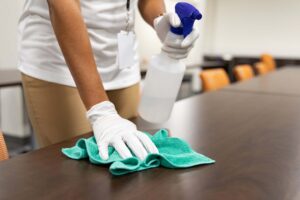As we navigate through 2024, numerous businesses are seeking strategies to enhance their operations and foster a healthy atmosphere for their employees and clientele.
A clean and well-maintained office environment plays a crucial role in achieving this goal.
However, when it comes to maintaining a pristine workspace, many people conflate cleaning, sanitizing, and disinfecting.
While these terms are often used interchangeably, they represent distinct processes, each critical in its own right for maintaining a healthy office.
In this article, we will break down the differences between cleaning, sanitizing, and disinfecting, explaining how each contributes to a safer and more productive office environment, as well as providing practical tips on how to implement these practices in your office building effectively.
Let’s dive in!
The Basics of Office Cleanliness
What is Cleaning?
At its core, cleaning is the process of removing visible dirt, dust, and organic substances from surfaces.
In an office environment, this can involve a variety of methods such as sweeping floors, vacuuming carpets, mopping, and wiping down surfaces with a clean cloth. Cleaning is essential because it eliminates the debris that can harbor germs, making surfaces easier to sanitize and disinfect later on.
However, it’s important to note that while cleaning removes physical grime, it doesn’t necessarily kill germs or bacteria.
What is Sanitizing?
Sanitizing goes a step beyond cleaning by reducing the number of bacteria on surfaces to safe levels as determined by public health standards. In an office setting, sanitizing can be accomplished using chemicals, heat, or ultraviolet light.
Unlike disinfecting, sanitizing doesn’t kill all germs, but it significantly lowers their numbers to reduce the risk of spreading infections. This step is particularly useful in common areas like break rooms and shared workspaces, where frequent contact with surfaces can lead to the transfer of bacteria.
What is Disinfecting?
Disinfecting is the process of using chemicals to kill germs and bacteria on surfaces. This is a critical step in preventing the spread of infections, especially in high-touch areas such as door handles, light switches, and shared office equipment.
Disinfecting goes beyond both cleaning and sanitizing by targeting and eliminating harmful pathogens.
Common disinfectants used in office buildings include bleach, alcohol-based solutions, and quaternary ammonium compounds.
Proper use of these disinfectants ensures that surfaces are not just visibly clean but also hygienically safe.
The Importance of Each Step
Cleaning: The Foundation
Cleaning is the essential first step in maintaining a healthy office environment.
By removing dirt, dust, and debris, cleaning lays the groundwork for more effective sanitizing and disinfecting.
Think of it as clearing the canvas before you begin to paint.
Without proper cleaning, sanitizing and disinfecting agents cannot reach the surfaces effectively, reducing their efficiency.
Clean surfaces not only look better but also feel more inviting and contribute to a more productive work atmosphere.
Sanitizing: The Second Line of Defense
After cleaning, sanitizing steps in to reduce the number of bacteria to safe levels. This is particularly important in areas where food is prepared or consumed, such as break rooms and kitchenettes.
Sanitizing also plays a vital role in shared spaces like conference rooms and common areas. By lowering the bacterial load, sanitizing helps to prevent minor illnesses and ensures a healthier workplace.
It’s a straightforward process that can make a significant difference in maintaining employee health.
Disinfecting: The Ultimate Protection
Disinfecting is the final and most aggressive step in the process.
This step is crucial for eliminating pathogens that can cause illnesses, particularly in high-touch areas like door handles, elevator buttons, and shared office equipment.
Disinfecting ensures that these areas are not just clean but also free from harmful germs.
Regular disinfecting routines can significantly reduce the risk of spreading infectious diseases, safeguarding the health of your employees and visitors.
Each of these steps builds upon the previous one, creating a comprehensive approach to office hygiene that supports a safer and more productive work environment.
Order of Operations
Maintaining a clean and healthy office environment requires following the correct sequence of steps: cleaning, sanitizing, and disinfecting.
Think of this process as a structured hierarchy where each step builds on the one before it, much like Maslow’s Hierarchy of Needs.
Step 1: Cleaning
Cleaning is the foundation of the hierarchy. Before any sanitizing or disinfecting can be effective, surfaces must be free of visible dirt and debris.
This means dusting, sweeping, vacuuming, and wiping down surfaces. Cleaning removes the physical particles that can shield germs and bacteria from sanitizers and disinfectants.
Step 2: Sanitizing
Sanitizing comes next, focusing on reducing the number of bacteria to safe levels.
After surfaces are cleaned, sanitizing solutions can penetrate more effectively, reducing the bacterial load on surfaces like countertops, desks, and other shared spaces.
This step is less aggressive than disinfecting but is crucial for maintaining daily hygiene, especially in areas where food is handled or in high-traffic zones.
Step 3: Disinfecting
Disinfecting is the final step, targeting and killing pathogens on surfaces. After cleaning and sanitizing, disinfecting solutions can work more effectively to eliminate germs.
This step is particularly important in high-touch areas such as door handles, light switches, and office equipment. Using disinfectants as a last step ensures that any remaining harmful microorganisms are eradicated, providing the highest level of hygiene.
By adhering to this order of operations, businesses can ensure that their cleaning efforts are as effective as possible, creating a safer and more pleasant environment for employees and visitors.
Practical Tips for Implementation
Implementing an effective cleaning, sanitizing, and disinfecting routine in your office doesn’t have to be daunting. Here are some practical tips to help you maintain a pristine workspace:
Establish a Cleaning Schedule
Create a regular cleaning schedule that covers daily, weekly, and monthly tasks. Daily tasks might include wiping down desks and high-touch surfaces, emptying trash bins, and vacuuming common areas.
Weekly tasks could involve more thorough cleaning of restrooms and kitchen areas, while monthly tasks might include deep cleaning carpets and upholstery.
Use the Right Products
Choose cleaning, sanitizing, and disinfecting products that are appropriate for your office environment. Make sure to use EPA-approved disinfectants that are effective against a broad spectrum of pathogens. Always follow the manufacturer’s instructions for proper use and dilution rates.
Train Your Staff
Ensure that your cleaning staff or janitorial service is well-trained in the proper techniques and sequence of cleaning, sanitizing, and disinfecting. They should understand the importance of each step and how to use the cleaning products safely and effectively.
Focus on High-Touch Areas
Identify and prioritize high-touch areas in your office, such as doorknobs, light switches, elevator buttons, and shared office equipment. These areas require more frequent cleaning and disinfecting to prevent the spread of germs.
Encourage Employee Participation
Promote a culture of cleanliness among your employees. Provide them with sanitizing wipes and hand sanitizers at their desks and encourage them to keep their workspaces tidy. Regular reminders about the importance of hygiene can help maintain a cleaner office environment.
Consider Professional Services
For the best results, consider hiring a professional cleaning service like 1 Stone Solutions.
Professionals have the expertise, equipment, and products to ensure your office is thoroughly cleaned, sanitized, and disinfected. They can also help you develop a customized cleaning plan tailored to your specific needs.
By implementing these practical tips, you can create a clean and healthy office environment that supports productivity and well-being.
Conclusion
Maintaining a clean, sanitized, and disinfected office is essential for fostering a healthy and productive work environment.
By understanding and implementing the distinct processes of cleaning, sanitizing, and disinfecting, you can significantly reduce the spread of germs and create a safer space for your employees and clients.
If you’re ready to elevate the cleanliness of your office space, reach out for a free consultation and discover the 1 Stone difference.



